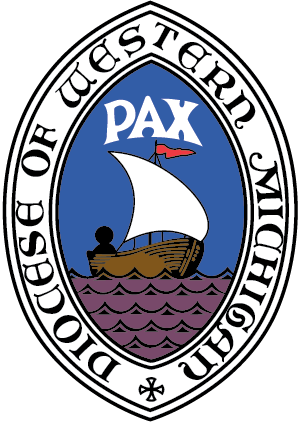Feast Days with Bishop Skip | The Visitation
It is hard to imagine what was likely a twelve to fourteen year old Mary taking off alone into the Judean hillside on a four-day journey, even if it was to visit her cousin Elizabeth as two mothers-to-be. Many assume that this meeting was not specifically historical, but a literary and theological device used by Luke to bring the two together so that both may praise the God active in their lives and establish John, Elizabeth’s son, as Jesus’ precursor.
None of this reduces the magic and delight of the scene, however. I find that every time I read it I have womb envy. It reminds me of Jacob and Esau “leaping” as they struggled in Rebekah’s womb, portending future relationships and the movement of God always on the arc of the liberation of God’s people. Even the encounter of Mary and Elizabeth is rife with themes of liberation.
On the darker side it all has the scent of crisis moments found in the Hebrew Scriptures surrounding the Exodus saga. Mary flees much as Moses fled after his crime. She is “untimely pregnant,” outside of the likely clan arrangement of her day. Her pregnancy is an affront to the social and religious order and therefore a crime punishable by death. God, however, sees life and possibility. For in the midst of it all, God is delivering into history the great liberator and prince of peace, Jesus the Christ. Light is promised.
Singing in exaltation infuses the moment as Elizabeth cries out her hymn, “Hail Mary.” Mary responds with the great hymn of liberation we know as the “Magnificat,” again connecting us to our Jewish roots through Hannah’s song of praise for God’s great acts of setting God’s people free.
I was making a call on an elderly woman who, according to her son, had not spoken for ten months. He joined me for this particular visit and spoke of the pain of not being able to communicate with her and wondered if anyone was “in there.” As our time unfolded in our visitation, I learned through the son of his mother’s great devotion to Mary. When I offered prayer, I led with “Hail Mary, full of grace, the Lord is with you,” Elizabeth’s words to the mother of Jesus. At that very moment his mother’s eyes took on recognition and she, in clearly enunciated English, joined us in the rest of the hymn. It was a moment of being set free for her son and for his mother, as later that night she died. Something leapt in all of us, the stirring movement of God’s Spirit always making new and redeeming what is right in front of us. It was a new day.
Mary and Elizabeth were open to the God-surprise in their own life circumstance. Each day gives us an opportunity to offer ourselves to this same possibility. We might even find ourselves singing new songs of hope and liberation for all God’s people.
Bishop Skip
Es difícil imaginar a la que probablemente era una María de entre doce y catorce años partiendo sola hacia la ladera de Judea en un viaje de cuatro días, aunque fuera para visitar a su prima Isabel como dos futuras madres. Muchos suponen que este encuentro no fue específicamente histórico, sino un recurso literario y teológico utilizado por Lucas para reunir a los dos y que ambos puedan alabar al Dios activo en sus vidas y establecer a Juan, el hijo de Isabel, como precursor de Jesús.
Sin embargo, nada de esto reduce la magia y el deleite de la escena. Me parece que cada vez que lo leo tengo envidia de vientre. Me recuerda a Jacob y Esaú “saltando” mientras luchaban en el vientre de Rebeca, presagiando futuras relaciones y el movimiento de Dios siempre en el arco de la liberación del pueblo de Dios. Incluso el encuentro de María y Isabel está plagado de temas de liberación.
En el lado más oscuro todo tiene el aroma de los momentos de crisis que se encuentran en las Escrituras hebreas que rodean la saga Éxodo. María huye como Moisés huyó después de su crimen. Está “intempestivamente embarazada”, fuera del probable arreglo del clan de su época. Su embarazo es una afrenta al orden social y religioso y, por lo tanto, a un delito castigado con la muerte. Dios, sin embargo, ve la vida y la posibilidad. Porque en medio de todo esto, Dios está entregando en la historia al gran liberador y príncipe de la paz, Jesús el Cristo. Se promete la luz.
Cantar en exaltación infunde el momento mientras Isabel grita su himno, “Ave María”. María responde con el gran himno de liberación que conocemos como el “Magnificat”, conectándonos de nuevo con nuestras raíces judías a través del canto de alabanza de Ana por los grandes actos de liberación del pueblo de Dios.
Estaba haciendo una llamada a una anciana que, según su hijo, llevaba diez meses sin hablar. Se unió a mí para esta visita en particular y habló del dolor de no poder comunicarse con ella y se preguntó si alguien estaba “allí”. En el transcurso de nuestra visita, me enteré a través del hijo de la gran devoción de su madre por María. Cuando ofrecía la oración, la encabezaba con “Ave María, llena de gracia, el Señor está contigo”, las palabras de Isabel a la madre de Jesús. En ese mismo momento los ojos de su madre adquirieron reconocimiento y ella, en un inglés claramente enunciado, se unió a nosotros en el resto del himno. Fue un momento de liberación para su hijo y para su madre, ya que esa misma noche murió. Algo saltó en todos nosotros, el movimiento conmovedor del Espíritu de Dios que siempre hace nuevo y redime lo que está frente a nosotros. Era un nuevo día.
María e Isabel estaban abiertas a la sorpresa de Dios en su propia circunstancia vital. Cada día nos da la oportunidad de ofrecernos a esta misma posibilidad. Incluso podríamos encontrarnos cantando nuevas canciones de esperanza y liberación para todo el pueblo de Dios.
Obispo Skip




